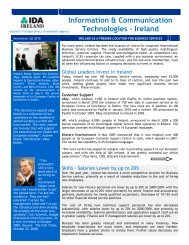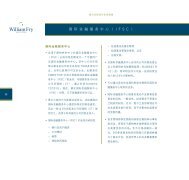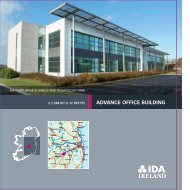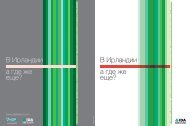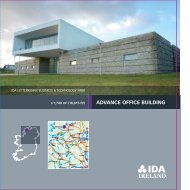Business Continuity Planning for an Influenza Pandemic - IDA Ireland
Business Continuity Planning for an Influenza Pandemic - IDA Ireland
Business Continuity Planning for an Influenza Pandemic - IDA Ireland
- No tags were found...
Create successful ePaper yourself
Turn your PDF publications into a flip-book with our unique Google optimized e-Paper software.
<strong>Business</strong> <strong>Continuity</strong> <strong>Pl<strong>an</strong>ning</strong> – Responding to <strong>an</strong> <strong>Influenza</strong> P<strong>an</strong>demic39<strong>Business</strong> <strong>Continuity</strong> <strong>Pl<strong>an</strong>ning</strong> <strong>for</strong> <strong>an</strong> <strong>Influenza</strong> P<strong>an</strong>demic:Case Study from a Software Comp<strong>an</strong>yIntroductionThis case study is one of ten written as a part of a study undertaken on <strong>Business</strong> <strong>Continuity</strong><strong>Pl<strong>an</strong>ning</strong> <strong>for</strong> <strong>an</strong> <strong>Influenza</strong> P<strong>an</strong>demic. The objective is to raise awareness among business enterprisesin Irel<strong>an</strong>d of the need <strong>for</strong> business continuity pl<strong>an</strong>ning (BCP) <strong>for</strong> the possible arrival of a ’flup<strong>an</strong>demic in Irel<strong>an</strong>d.The case study is based on a composite from a number of real businesses, <strong>an</strong>d is fictionalisedin some respects, including the name.As this comp<strong>an</strong>y, like m<strong>an</strong>y in Irel<strong>an</strong>d, is only beginning to appreciate the need to pl<strong>an</strong> <strong>for</strong> <strong>an</strong>influenza p<strong>an</strong>demic, its pl<strong>an</strong> is not yet complete. The case study necessarily reflects this continuingpl<strong>an</strong>ning process.BackgroundDiltisys is a Dublin-based software comp<strong>an</strong>y, which was established in the late 1990s. Its businessis based on licensing its fin<strong>an</strong>cial software product, <strong>an</strong>d on providing associated services, bothremotely from its Irish operation <strong>an</strong>d on-site.It has a number of customers in Irel<strong>an</strong>d <strong>an</strong>d the UK, <strong>an</strong>d has made its first sales in the US. It isworking hard at growing its sales in North Americ<strong>an</strong> markets, <strong>an</strong>d is developing its product to bettermeet the needs of US customers.It employs 40 staff in Irel<strong>an</strong>d <strong>an</strong>d three in the UK. It has a small US office with two Americ<strong>an</strong> salesstaff <strong>an</strong>d two Irish engineers.1: <strong>Pl<strong>an</strong>ning</strong> ActivitiesThe m<strong>an</strong>agement team agreed that the Hum<strong>an</strong> Resources M<strong>an</strong>ager should take the lead in pl<strong>an</strong>ning<strong>for</strong> the possibility of <strong>an</strong> influenza p<strong>an</strong>demic, as m<strong>an</strong>y of the key issues were felt to relate to peoplem<strong>an</strong>agement.She consulted in<strong>for</strong>mation from a r<strong>an</strong>ge of sources. These included the Department of Health<strong>an</strong>d Children <strong>an</strong>d the World Health Org<strong>an</strong>isation, the material on p<strong>an</strong>demic influenza preparednesspublished by Forfás, <strong>an</strong>d also material from the US <strong>an</strong>d the UK where the comp<strong>an</strong>y is active. Inaddition, she also consulted with her counterparts in other Irish software comp<strong>an</strong>ies throughthe industry org<strong>an</strong>isation.She consulted with other members of the m<strong>an</strong>agement team, including the Vice-Presidentsresponsible <strong>for</strong> sales, <strong>an</strong>d <strong>for</strong> consulting & services, who m<strong>an</strong>age the overseas-based staff.She developed a draft pl<strong>an</strong>, <strong>an</strong>d after discussing it with the CEO, brought it to the m<strong>an</strong>agementteam <strong>for</strong> discussion <strong>an</strong>d sign-off. As part of this process, the team worked through the implicationsof a scenario based on a fairly severe p<strong>an</strong>demic with signific<strong>an</strong>t staff absences <strong>an</strong>d disruption tointernational travel.
40 <strong>Business</strong> <strong>Continuity</strong> <strong>Pl<strong>an</strong>ning</strong> – Responding to <strong>an</strong> <strong>Influenza</strong> P<strong>an</strong>demic2: Issues to be AddressedThe Hum<strong>an</strong> Resources M<strong>an</strong>ager considered the activities within the comp<strong>an</strong>y that are criticalto business continuity. She decided that these fell into two categories:n Some activities are required to keep the comp<strong>an</strong>y operating day to day, such as IT systems<strong>an</strong>d customer support.n Some activities, particularly sales <strong>an</strong>d work on product development have to continue if thecomp<strong>an</strong>y is to meet timing-critical constraints on its success <strong>an</strong>d survival. The window ofopportunity is of limited duration. The business has to satisfy its investors on meeting agreedmilestones. Unpl<strong>an</strong>ned delays in obtaining a return on its investments in product development<strong>an</strong>d sales could <strong>for</strong>ce the comp<strong>an</strong>y into seeking more funding, which might not be successful,<strong>an</strong>d which would in <strong>an</strong>y case dilute the founders’ shareholdings.Consulting with the other members of the m<strong>an</strong>agement team, <strong>an</strong>d with the systems m<strong>an</strong>ager,she concluded that there would be scope <strong>for</strong> m<strong>an</strong>y staff to telework. The comp<strong>an</strong>y already has therequired infrastructure, <strong>an</strong>d most staff have broadb<strong>an</strong>d access at home. There are limits to whatc<strong>an</strong> be done at home arising from security <strong>an</strong>d work process considerations, <strong>an</strong>d there could alsobe productivity issues. However, teleworking could allow m<strong>an</strong>y staff to keep working if kept outof the office by sick dependents, school closures or moves to limit the risk of workplace infection.Some staff (mainly in sales <strong>an</strong>d consulting) spend relatively little time in the office under normalcircumst<strong>an</strong>ces in <strong>an</strong>y case.<strong>Business</strong> continuity requires that the comp<strong>an</strong>y’s customer support services <strong>an</strong>d IT systems arekept in operation. As the number of people working in these areas is small, continuity could bethreatened if a small number of people became ill simult<strong>an</strong>eously.The Vice-President responsible <strong>for</strong> sales observed that the sales environment might become moredifficult during a p<strong>an</strong>demic. It might become more difficult to get the attention of customers, ascomp<strong>an</strong>ies become more concerned about continuity in the systems already in place, giving themless time to think about new developments. Some customers might avoid face-to-face meetings,<strong>an</strong>d, indeed, sales staff might have concerns about face-to-face meetings themselves.Disruption to travel might also have a negative impact on sales activity. Difficulties in flyinginternationally, or internally within the US could make meeting with customers meetings by salesstaff <strong>an</strong>d senior executives difficult to arr<strong>an</strong>ge, even without <strong>an</strong>y reluct<strong>an</strong>ce to meet face-to-face.The Vice-President responsible <strong>for</strong> consulting <strong>an</strong>d service observed that <strong>an</strong>y issues with meetingcustomers face-to-face or with travel could also make it difficult <strong>for</strong> his staff to do their jobs.3: Measures to Underpin <strong>Continuity</strong>Measures envisaged in the pl<strong>an</strong> to underpin business continuity include the following:n The comp<strong>an</strong>y already has a system of deputies in place to allow business to continue when keym<strong>an</strong>agers are travelling, <strong>an</strong>d it is envisaged that this will be used if needed during a p<strong>an</strong>demic.n The pl<strong>an</strong> envisages making the comp<strong>an</strong>y more resilient to staff absences in customer serviceby introducing occasional cross-training sessions <strong>for</strong> technology staff.n A small number of technology staff will be nominated as deputies <strong>for</strong> IT systems staff, <strong>an</strong>d willbe trained in the basics of keeping the comp<strong>an</strong>y’s systems up.
<strong>Business</strong> <strong>Continuity</strong> <strong>Pl<strong>an</strong>ning</strong> – Responding to <strong>an</strong> <strong>Influenza</strong> P<strong>an</strong>demic41n The comp<strong>an</strong>y already has home contact details <strong>for</strong> its employees. The pl<strong>an</strong> envisages circulatingstaff with e-mail messages, <strong>an</strong>d using telephone contacts if <strong>an</strong>y in<strong>for</strong>mation has to bedisseminated urgently. The comp<strong>an</strong>y will use its website <strong>for</strong> customer <strong>an</strong>d staff communications.n The Vice-Presidents responsible <strong>for</strong> sales <strong>an</strong>d <strong>for</strong> consulting & services will work togetherto develop practical approaches to working with customers during <strong>an</strong> influenza p<strong>an</strong>demic.n The Hum<strong>an</strong> Resources M<strong>an</strong>ager will assess the healthcare options available to US-based staff,<strong>an</strong>d will confirm that their health insur<strong>an</strong>ce will cover <strong>an</strong>y necessary treatment.n In the event that the WHO influenza p<strong>an</strong>demic alert level rises to 5 (signific<strong>an</strong>t hum<strong>an</strong>-to-hum<strong>an</strong>tr<strong>an</strong>smission), the comp<strong>an</strong>y will develop a policy on overseas travel taking account of the potential<strong>for</strong> a p<strong>an</strong>demic. M<strong>an</strong>agers <strong>an</strong>d team leaders will also start pl<strong>an</strong>ning how best to use teleworkingduring a p<strong>an</strong>demic.4: Response to Workplace RiskMeasures pl<strong>an</strong>ned to respond to workplace risk include the following:n The comp<strong>an</strong>y envisages facilitating staff in teleworking in the event of a p<strong>an</strong>demic, particularlyat the height of waves of infection. Depending on the severity of the p<strong>an</strong>demic, it may activelyencourage staff to telework.n Face-to-face meetings with customers are likely to be less common in the event of a p<strong>an</strong>demicin <strong>an</strong>y case.n Staff will be advised to follow the Department of Health’s guidelines on respiratory hygienein the event of a p<strong>an</strong>demic. They will be asked not to use each others’ telephones, computers,desks or chairs.n The comp<strong>an</strong>y will lay in a stock of cle<strong>an</strong>ing <strong>an</strong>d h<strong>an</strong>d hygiene materials to be used in the eventof a p<strong>an</strong>demic.n Face-to-face contact between staff will be reduced to some extent, although there are limits towhat is possible in the open pl<strong>an</strong> offices where the majority of staff work. If numbers in the officeare reduced, it may be possible to reduce mixing between teams.n Cle<strong>an</strong>ing will be stepped up during a p<strong>an</strong>demic.n During a p<strong>an</strong>demic, staff will be encouraged to choose non-classroom approaches to training<strong>an</strong>d learning.Challenges of <strong>Pl<strong>an</strong>ning</strong> <strong>for</strong> a ’Flu P<strong>an</strong>demicA small, internationally focused software comp<strong>an</strong>y like Diltisys c<strong>an</strong>not af<strong>for</strong>d to let its existingcustomers down, <strong>an</strong>d c<strong>an</strong>not af<strong>for</strong>d to interrupt its sales ef<strong>for</strong>ts or development work. Maintainingcontinuity in these areas in the face of staff absences <strong>an</strong>d ch<strong>an</strong>ged customer behaviour will be achallenge.ConclusionAn influenza p<strong>an</strong>demic poses signific<strong>an</strong>t potential risks to a software comp<strong>an</strong>y, both in terms ofpeople availability, <strong>an</strong>d access to customers. While small software comp<strong>an</strong>ies often have difficultyin looking beyond their immediate short term priorities, it is worthwhile <strong>for</strong> them to give somethought to business resilience in the event of <strong>an</strong> influenza p<strong>an</strong>demic.



